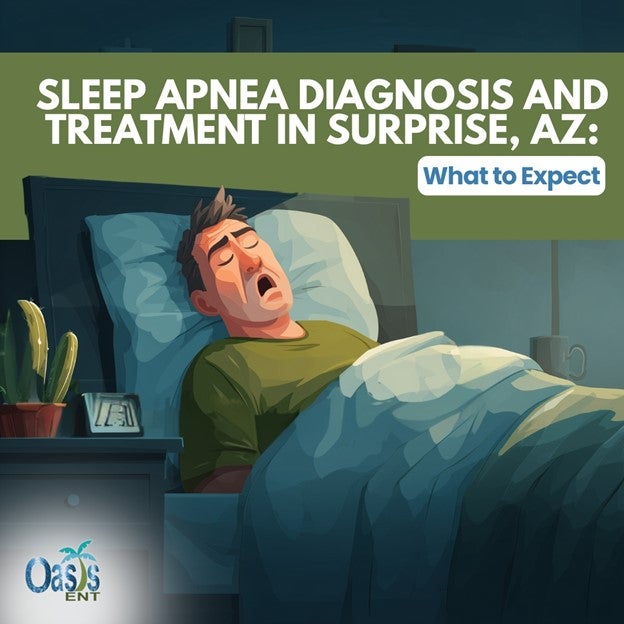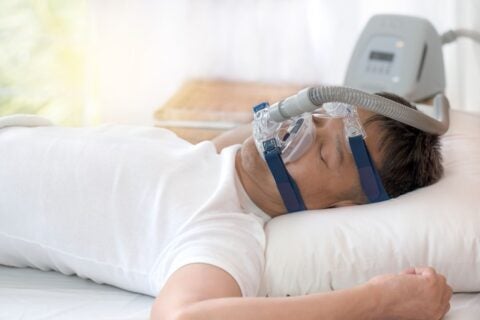Sleep Apnea Diagnosis and Treatment in Surprise, AZ: What to Expect
If you or a loved one struggles with loud snoring, waking up gasping for air, or constant fatigue, sleep apnea may be the cause. This common but serious condition affects breathing during sleep and can have long-term health effects if left untreated. At Oasis ENT in Surprise, AZ, we work with patients every day who are searching for answers. Understanding how sleep apnea is diagnosed and what treatment options are available—including CPAP alternatives—can help you better understand your options and take an informed next step.

What Is Sleep Apnea?
Sleep apnea happens when your airway becomes blocked or narrowed while you sleep, causing pauses in breathing. These interruptions can happen dozens of times per night.
The two most common types are:
- Obstructive Sleep Apnea (OSA): Caused by relaxed throat muscles blocking the airway.
- Central Sleep Apnea: Less common, caused by the brain not sending proper signals to control breathing.
In Surprise, AZ, obstructive sleep apnea is far more common. Symptoms often include:
- Loud, chronic snoring
- Waking up choking or gasping
- Daytime fatigue and brain fog
- Morning headaches
- Irritability or trouble focusing
If these symptoms sound familiar, consider consulting a medical provider for an evaluation.
How Sleep Apnea Is Diagnosed
The first step in diagnosing sleep apnea is meeting with an ENT who understands both sinus and airway conditions. At Oasis ENT in Surprise, we start with a thorough exam and a discussion of your symptoms. If sleep apnea is suspected, the most accurate way to confirm it is with a sleep study.
What to Expect from a Sleep Study in Surprise
A sleep study records your breathing, oxygen levels, and sleep stages. There are two main types:
- In-lab sleep study: Done overnight at a sleep center, this provides detailed results.
- Home sleep study: Conducted in your own bed with a small device, this is often more convenient but still effective for many patients.
Your ENT will recommend the best option based on your symptoms and overall health. Once results are reviewed, your provider can determine the severity of the condition and discuss treatment options that may be appropriate.
Common Treatment Options
CPAP Therapy
The most common treatment is a Continuous Positive Airway Pressure (CPAP) machine, which keeps your airway open by gently blowing air through a mask. While CPAP is often effective, some patients find it challenging to use consistently.
CPAP Alternatives
If CPAP doesn’t work for you, there are several alternatives, including:
- Oral appliances: Custom-fitted mouthpieces that reposition the jaw to keep the airway open.
- Lifestyle changes: Weight management, avoiding alcohol before bed, and sleeping on your side can improve mild cases.
- Surgical options: For patients with blocked airways due to enlarged tonsils, nasal obstruction, or soft tissue collapse, procedures may help open the airway.
- Balloon sinuplasty (for sinus-related issues): In cases where nasal obstruction contributes to sleep-disordered breathing, this procedure may help improve airflow. Your provider can determine whether it’s appropriate based on a full evaluation.
Your ENT can help decide which approach is best based on your diagnosis and comfort level.
Why Treatment Matters
Untreated sleep apnea does more than make you tired. Over time, it can increase the risk of high blood pressure, heart disease, stroke, and type 2 diabetes. Some individuals also report improved quality of life and reduced strain on relationships once disruptive symptoms—such as snoring—are managed.
Treating sleep apnea may help improve sleep quality and support long-term health outcomes when appropriately managed.
Take the First Step Toward Better Sleep in Surprise, AZ
Sleep apnea doesn’t have to control your life. With the right diagnosis and treatment plan, you can enjoy more restful nights and better overall health. At Oasis ENT in Surprise, AZ, we guide patients through every stage—from sleep studies to CPAP alternatives—to find solutions that fit their needs.
If you’re ready to finally understand what’s behind your symptoms and explore treatment options, our team is here to help. Improved sleep and overall well-being may be achievable.—starting with the right diagnosis and an individualized care plan.

